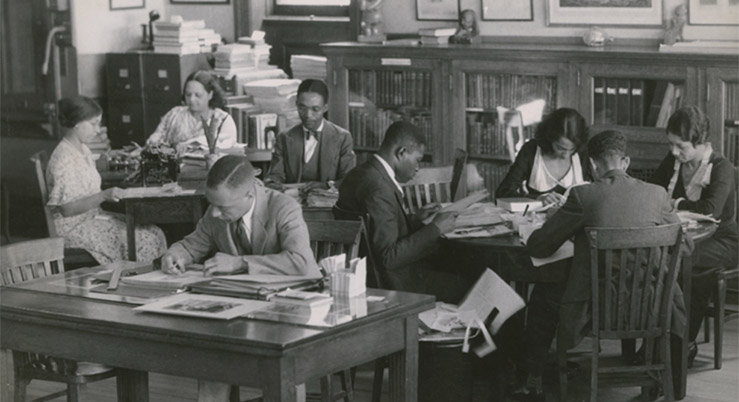VCU Libraries is key partner in Digital Virginias, newest hub of Digital Public Library of America.
January 9, 2019
New this semester, Digital Virginias, offers more than 58,000 items for research and exploration.
Launched this week as part of the Digital Public Library of America (DPLA) and created by organizations from Virginia and West Virginia, Digital Virginias is the newest hub to join the nationwide digital project that includes contributions from the nation’s leading repositories. National partners include the Smithsonian Institution, National Archives and Records Administration, the New York Public Library and collectives representing most of the 50 states.
Partners in the Virginias project including the University of Virginia, George Mason University, the College of William and Mary, Virginia Commonwealth University, Virginia Tech, and West Virginia University created a combined set of historical materials for the region. Digital Virginias will also begin to bring in additional regional partners in 2019.
The Digital Public Library of America is a unique nationwide collective working to bring the riches of the nation’s cultural heritage to a broad, engaged public. Millions of items are available to users through DPLA.
VCU’s role in the project is as a member and a founding partner for the Digital Virginias hub. VCU staff, under the leadership of VCU Libraries Head of Digital Engagement Erin White, worked to establish the hub partnership and prepare VCU digitized materials for inclusion in the national platform. As the project grows over time, VCU will partner with regional cultural heritage organizations to help add their materials into DPLA, too.
“My hope is that this is just the beginning of a Virginias digital collaboration that leads to further collaboration, standardization and dissemination of unique digital content,” says White.
Selections from the collections of Digital Virginias include:
Jackson Davis Collection of African American Educational Photographs
Jackson Davis, an educational reformer and amateur photographer, took nearly 6,000 photographs of African-American schools, teachers, and students throughout the southeastern United States. His photographs—most intended to demonstrate the wretched conditions of segregated and unequal African American schools in the South and to show how they could be improved—provide a unique view of southern education during the first half of the 20th century.
George Mason University Yearbook Collection
Yearbooks are the door to the past, and this collection of more than 40 yearbooks and related publications documents the history of George Mason University students, campuses, faculty, and activities from 1957 to 2011. In 1957, the University College of the University of Virginia opened in an elementary school in Bailey’s Crossroads with 17 students. From this small start, George Mason University has grown into one of Virginia’s largest public university universities.
James Monroe Project
James Monroe, an American statesman and Founding Father, served as the fifth President of the United States from 1817 to 1825. The James Monroe Project brings together more than 300 manuscripts from six distinct collections held by the William & Mary Libraries Special Collections Research Center. The materials are chiefly correspondence, written and received by James Monroe and his family. Ranging from 1776-1924, the materials include the correspondence of James Monroe during his many years of public service.
Farmville 1963 Civil Rights Protests
During the summer of 1963, civil rights activists staged a number of protests in Farmville, Va., the county seat of Prince Edward County, demanding equality and an end to racial segregation and injustice. This collection of 491 photographs from Virginia Commonwealth University Libraries shows dozens of Prince Edward County African-American students and others protesting to draw attention to racial discrimination. Many of the black-and-white photographs were taken by a photographer hired by the Farmville Police Department and were intended to be used in court proceedings as evidence against protesters who were arrested.
Barter Theatre Archives
The Barter Theatre in Abingdon, Va. has been a cultural mainstay in southwestern Virginia since its beginning in 1933 when Robert Porterfield, a charismatic young actor and southwest Virginia native, brought a group of professional actors to Abingdon. Opening in the midst of the Great Depression, the theatre got its name from its practice of allowing audiences to barter food for admission to the theatre. From humble beginnings, Barter put down roots in the small community of Abingdon, establishing a reputation for providing performances of high artistic quality. The Barter Theatre Archives collection, made accessible with support from Virginia Tech Libraries Digital Imaging & Preservation Services, includes more than 200 programs, posters, and news clippings.
Rush Dew Holt Collection
To say Rush Holt was “precocious” would be an understatement. In 1934, at age 29, he became the youngest person ever elected to the United States Senate, a distinction he continues to hold to this day. Though his term was to begin on January 3, 1935, Senator Holt was literally too young to serve. Rush Holt became the real life model for the role of “Senator Jefferson Smith” as portrayed by actor Jimmy Stewart in Mr. Smith Goes to Washington. He was the subject of literally hundreds of political cartoons in newspapers across America, and the originals of many ended up at the West Virginia and Regional History Center at the West Virginia University Libraries.
< Previous Next >
 Chat
Chat